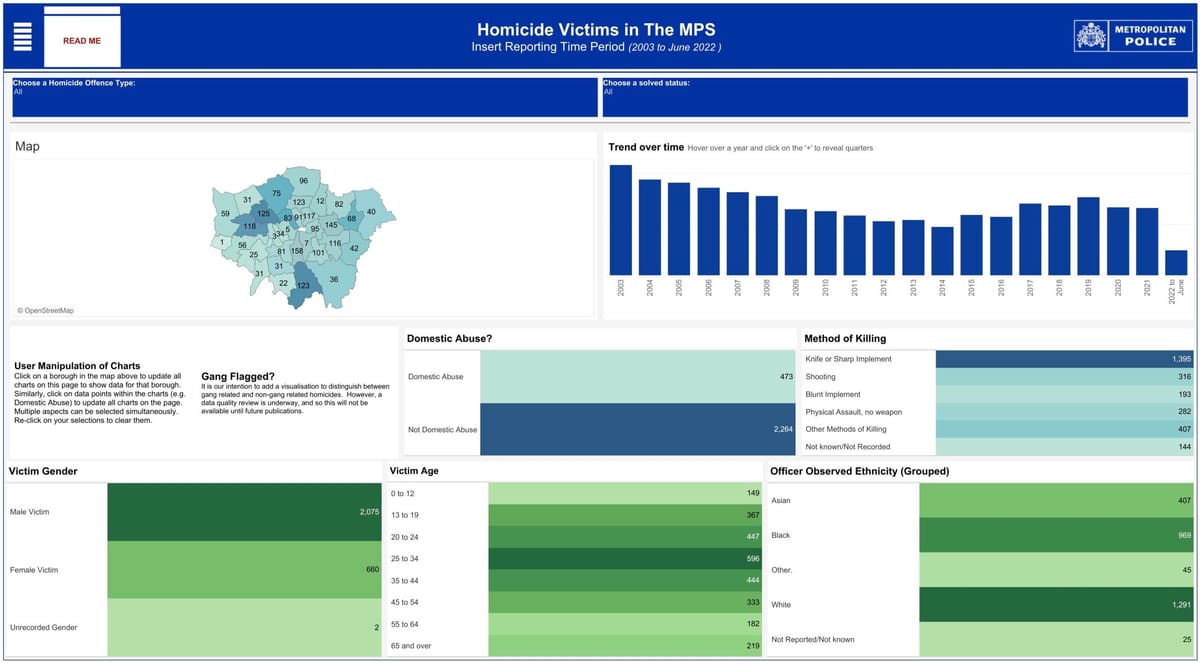Rising Murder and Manslaughter Rates in London

By Lilly Donald, LLB Law
The significant increase in murder and manslaughter rates in London has been ongoing in recent years, as homicide rates have slowly risen since 2014. Over 100 people each year are victims of homicide in London alone; 2019 was labelled London’s bloodiest year, with 149 recorded people killed – an increase of over 50% since 2014 (94 cases) and the highest rate recorded by the London Metropolitan Police in 11 years. Two years later, in 2021, another record was broken, 30 teenagers were killed, the majority of them being victims of fatal stabbings, with the youngest victim being only 14 years old. This record was reported to be the highest rate of teen homicides since World War II. 74.4% of all homicides in 2021 were caused by knives or sharp implements – a 15.6% increase from 2020 – highlighting the increase, over the last decade, of homicides caused by knife crime. This year, out of the 92 alleged homicides so far, 12 have been teenage murders. A spokesperson for the Metropolitan police said, ‘each and every homicide is devastating – these victims are not just statistics and not just numbers,’ they all have families, and they all should have had their lives ahead of them.
“2021 was reported to be the highest rate of teen homicides since World War II with 74.4% of cases caused by knives or sharp implements.“
COVID-19 affected the statistics of homicide rates in London, as the legal sanctions introduced restrictions on movement and socialising. However, this only delayed crime rather than prevented it. The Metropolitan Police show that in 2020, the annual homicides reached their peak in July, with 19 murders in that month alone; this figure correlates with the lockdown restrictions in May 2020, enforcing the fact that COVID restrictions delayed crime and homicide rates in London, as rates have since increased. Although homicides in residential settings increased by 5%(2021).
The causation of the rising homicide rates is not a simple question to be asked, and it can fall upon various reasons. Ben Bradford, professor of Global City Policing at UCL, who has worked with the London Metropolitan Police and the Mayor’s Office for Policing and Crime, stated that drugs, austerity and the rise in violence in youth cultures are key factors in London’s rise in crime. Furthermore, mental health, gangs, social media, notions of masculinity and, more recently, the cost of living crisis can all also be considered for rising homicide rates in London. The disproportionate numbers of teenagers, communities of colour and higher rates of poverty affected by these tragedies have impacted these communities and left families devastated.
One way the government is attempting to tackle these occurrences is the notable increase in police officers. In March 2019, there were 31,063 officers part of the London Metropolitan Police, which increased to 34,895 in June 2022. However, increased policing is not the solution to the problems presented, as explained by Ben Bradford, ‘the problems we are talking about do not have a policing solution. Policing is quite good at keeping a lid on problems, but it can’t provide long-term solutions. That lies with health, education and social services, and they have to provide the long-term solutions.’.
The work of the Mayor of London’s Violence Reduction Unit (VRU) has shown more promising solutions to increased homicide rates, through the introduction of the London Police and Crime Plan 2021-2025. The VRU’s past work has funded 16 programmes to provide positive opportunities for young people, supported 15 schools to deliver more inclusive education for all children, and £7m in funding for schools and pupil referral units. Currently, the VRU is focused on five key areas: education and schools, early intervention, youth work, young people and communities. For example, £750,000 to each in funding, is to be given in April 2023 to Croydon, Haringey, Newham, Southwark, Lambeth, Brent, Hackney and Tower Hamlets as, through their research, they have found the ‘most effective way to prevent violence in these communities is to provide leaders from these communities with resources to enhance prevention measures’. Another example is the VRUs focus on reducing school exclusions by investing in the charity Nurture, which builds on work schools are doing to be inclusive and nurturing to support the reduction in the number of children excluded from school. As studies have shown a link between school exclusions and violent crime.
The Framework Analysis by the VRU, released in November 2022, is to analyse police data and identify opportunities to intervene earlier, is another move from the government to better understand homicide in London, as information is from 50 previous homicide cases. Lib Peck explains ‘ the analysis and insights [the Framework Analysis report] opens up will help practitioners, police officers, policymakers, and researchers better understand the drivers of homicide in the capital and highlight where we can best target resources’. Reflecting a promising start to changes in our infrastructure in crime prevention, with the next phase studying another 300 cases.
Photo Caption: Homicide Victims in the MPS (Credit: Metropolitan Police).



